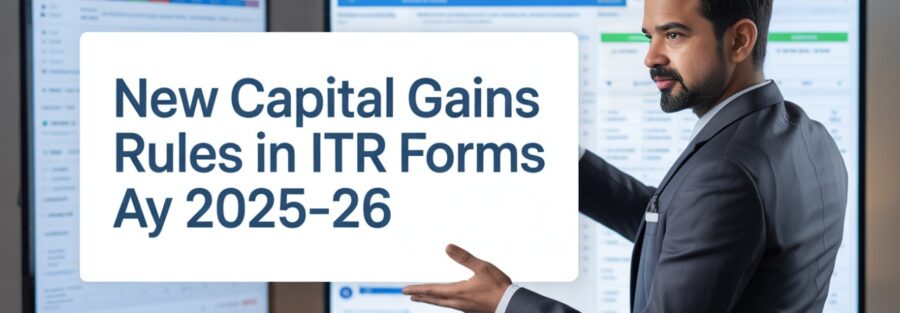What Every Taxpayer Must Know Before Filing!
🏁 Introduction
The Income Tax Return (ITR) forms for Assessment Year (AY) 2025–26 have seen a major overhaul — especially regarding capital gains reporting. These changes are part of a wider effort by the Income Tax Department to make tax filing more accurate, data-driven, and transparent.
Whether you’re a salaried individual investing casually in mutual funds or an active trader dealing in shares, crypto, or property, these updates directly impact how you file your returns.
At IndiaFills, our goal is to simplify this evolving tax landscape. We help you decode the new ITR forms, avoid mistakes, and ensure maximum compliance — all while saving your time and money. 📥💼
🆕 What’s New in ITR Forms AY 2025–26?
The updated ITR forms (ITR-1, 2, 3, and 4) have introduced deeper integration of capital gains reporting and have improved overall usability. Here’s what’s been rolled out:
✅ Clearer Categorization of Capital Gains:
Capital gains are now better structured — split between short-term (STCG) and long-term (LTCG), equity vs. non-equity, and residential vs. non-residential assets.
✅ Enhanced Schedule CG:
The new Schedule CG auto-pulls data from your Annual Information Statement (AIS) and includes additional fields like Fair Market Value (FMV), date of acquisition/sale, and cost of improvement.
✅ Pre-Filled Data From AIS/TIS:
Many details are auto-filled to reduce manual entry errors and to ensure alignment with the information already available to the tax department.
✅ Excel Utilities Available for All Filers:
You can now file using offline Excel utilities for ITR-1 to ITR-4. These utilities are equipped with formulas, dropdowns, validations, and even pre-filled sections from earlier submissions.
These changes aim to reduce mismatches with broker summaries, AIS data, and investment reports, thereby reducing the chances of notices and reassessments.
💸 Detailed Capital Gains Reporting – What Changed?
The biggest change is how you now report and declare capital gains. Here’s what you need to include:
📌 ISIN-wise Reporting for Listed Shares
Every sale of listed shares requires ISIN details, date of acquisition, sale value, and purchase cost. This is especially important for long-term equity gains, where grandfathering rules may apply.
📌 Separate Reporting for Debt Mutual Funds
With new rules classifying many debt mutual funds as non-equity, these need to be reported distinctly under short-term or long-term capital gains depending on the holding period.
📌 Indexed Cost Computation
For LTCG on non-equity assets, indexation plays a major role in reducing tax liability. The new forms now make this more structured and visible.
📌 NRI Capital Gains & Foreign Assets
If you’re an NRI or hold foreign assets, you need to report residential status-wise capital gains, asset location, and foreign taxes paid (if any) for DTAA relief.
IndiaFills helps you extract all this information accurately, even from raw broker statements or consolidated reports.
🧾 Which ITR Form Should You Choose?
Here’s a quick breakdown:
- ITR-1 (Sahaj): For salaried individuals with no capital gains.
- ITR-2: Best for individuals with capital gains and no business income.
- ITR-3: Suitable for business owners, freelancers, traders, or those with both capital gains and business income.
- ITR-4 (Sugam): For presumptive income taxpayers, not valid if you have capital gains.
🔍 Using the wrong form? It can result in a defective return notice (Section 139(9)), delaying refunds and compliance.
📊 Excel Utilities & Smart Filing Support
The new Excel-based offline utilities for ITR-1 to ITR-4 are powerful tools:
✨ Pre-filled PAN, bank, and salary data
✨ Built-in error checking with formula validations
✨ Automatically generated schedules (CG, OS, TDS, etc.)
✨ Option to import capital gains CSV from brokers
These utilities help you file faster and more accurately, especially when used alongside IndiaFills capital gain computation sheets.
⚠️ Common Mistakes to Avoid
🚫 Filing ITR-1 when you have capital gains
🚫 Not entering ISINs or omitting PAN of the company in sale reports
🚫 Ignoring data mismatch with AIS/TIS
🚫 Missing indexation benefits
🚫 Skipping grandfathering rules for LTCG on equity shares (acquired before Jan 31, 2018)
Even one error can delay your return or result in a notice under Section 143(1). Let IndiaFills handle it all with precision.
🤝 How IndiaFills Can Help You
Here’s how we simplify capital gains and ITR filing for you:
✅ Help you choose the correct ITR form
✅ Compute accurate capital gains across stocks, MFs, crypto, and property
✅ Fill Excel utilities for ITR-2 & ITR-3 flawlessly
✅ Guide NRIs on DTAA and foreign income
✅ Full support via WhatsApp, Email, and Phone
📧 Contact: indiafills@gmail.com
📲 Join Our WhatsApp Channel: Click Here
📝 Final Thoughts
The new capital gains reporting rules and updated ITR forms for AY 2025–26 reflect India’s move towards data-driven tax compliance. While the forms are more powerful, they’re also more complex. From detailed CG schedules to form-specific eligibility, there’s no room for guesswork.
💡 IndiaFills is here to make tax filing stress-free and efficient, especially when capital gains are involved. Whether you’re a salaried individual, NRI, or a full-time trader — we’ve got your back!
📸 Image Suggestion for Blog
- Title: New Capital Gains Reporting AY 2025–26
- Alt Text: New Capital Gains Reporting Rules ITR AY 2025–26




